
The cost to paint the interior of a house in Dallas, TX depends on size, layout, type of surface, and more. Learn what factors can influence your total in this guide.
The texture is faux, but the appeal is real


There are several different faux painting techniques you can use to add the illusion of texture to your walls. Sponging, color washing, and rag rolling are just a few creative ways to set your space apart. These specialty painting techniques require some skill and patience to apply, but the final product can add tons of depth to your room.
Specialty painting is a decorative painting technique that uses unique applications to add distinctive textures, finishes, and effects. For example, faux finishes can mimic the look of wood, marble, or fabric, while metallic finishes offer a shimmering glaze.

Sponging is probably one of the first faux painting techniques you’ll consider, and it’s also one of the easiest to apply. You simply paint one or two base coats and then use a sea sponge to apply a second color or shade. The base layer shines through the top coat, creating a random textured look.
This is a common faux painting technique for accent walls and chimneys, and given how hard it is to mess up, it’s a great option for beginner DIYers to add some depth and texture to their homes.
| Pros | Cons |
|---|---|
| Fun to apply | Can look busy |
| Affordable | Only feasible for small surfaces |
| Quirky and creative appearance | Drips and runs easily |
Best for: Creating texture on small areas, like chimneys or small accent walls

Color washing creates an antique, weathered look on your surface, so it’s a good option for making an accent wall or piece of furniture look aged and worn, even if it’s brand new. To use this technique, you’ll paint in small cross-hatch patterns across your surface with half paint and half glaze on a brush. This creates a splotchy appearance that adds some subtle depth.
Color washing is another simple faux painting technique that adds charm and character to your room. With no special tools required and a simple application process, this is an affordable option, even for inexperienced DIYers.
| Pros | Cons |
|---|---|
| Easy to apply | Can look dated |
| No special tools | Difficult to undo |
| Unique, subtle texture | Limited color options |
Best for: Creating a subtle aged appearance

For a more drastic aged appearance, you can try rag rolling instead of color washing. Rag rolling leaves a more obvious splotchy top coat over your base color, creating more depth and a more weathered appearance.
This technique involves painting a section of your wall with a base coat and then going over that with a second color before the first dries. For the second coat, you’ll use twisted or bunched-up rags on a paint roller, and you can use rubber bands to hold them in place while you work. If you work in small sections and apply the top coat before the base layer dries, this is a simple and quick faux painting technique with a big impact.
| Pros | Cons |
|---|---|
| Easy to apply | Can look dated |
| No special tools | Drastic appearance |
| One of the fastest methods | Hard to keep consistent |
Best for: Homeowners who want a more drastic aged look on their surfaces
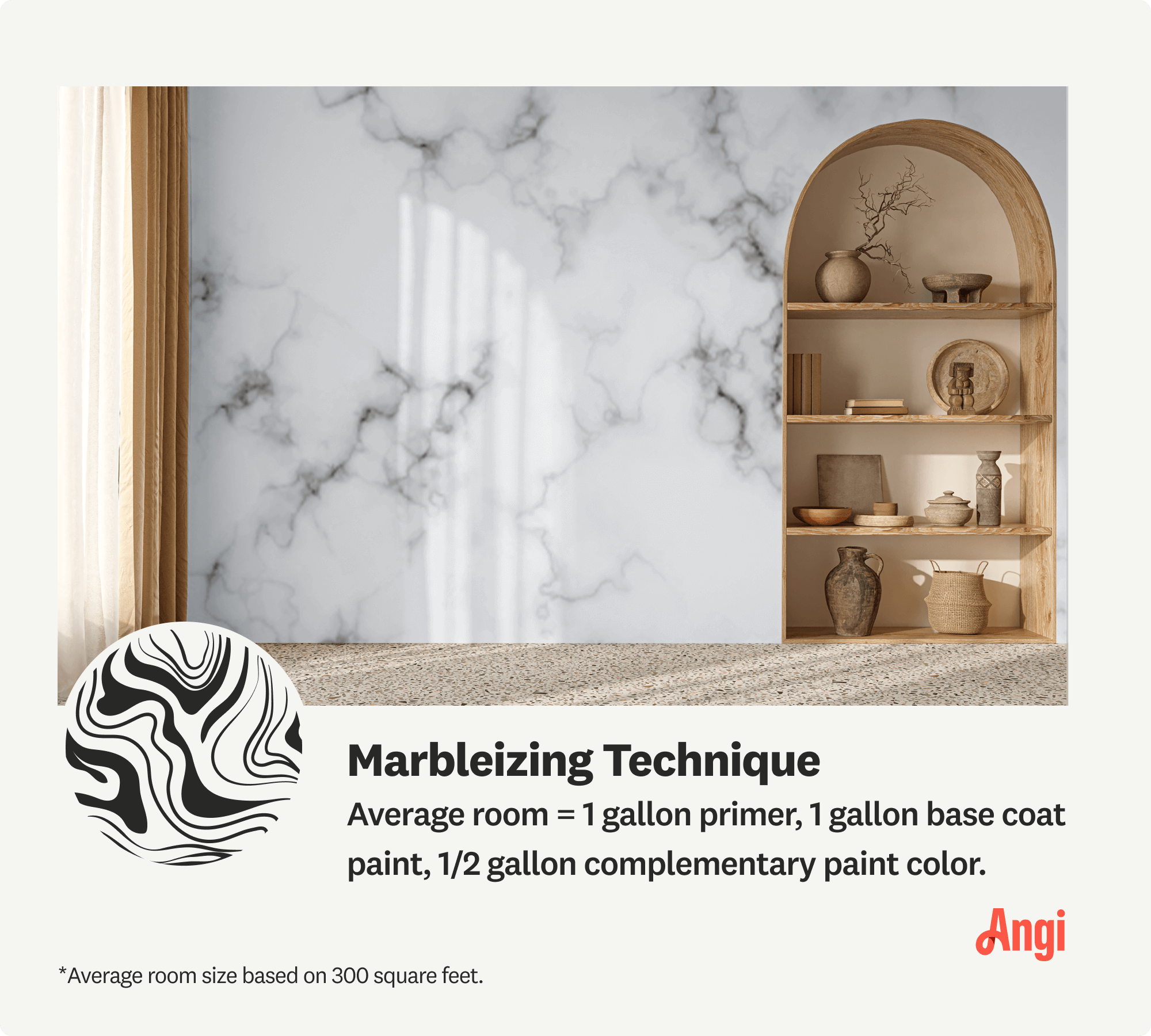
If you love the look of natural marble but aren’t thrilled with the price tag, marbleizing might be the right faux painting technique for you. This creates the appearance of marble on your surface for a fraction of the cost if you can manage it as a DIY project. This is an advanced technique, though, so you may end up having to hire a local interior painting company to get it to look right.
To marbleize a surface, paint a base coat, wait for it to dry, and then use rags and a thin paintbrush with multiple glaze colors to mimic the natural vein patterns of marble.
| Pros | Cons |
|---|---|
| Natural appearance | Expensive |
| High-end look | Hard to apply |
| Interesting style | Can appear unattractive |
Best for: Experienced DIYers who want to add cooler textures to small accent walls or furniture
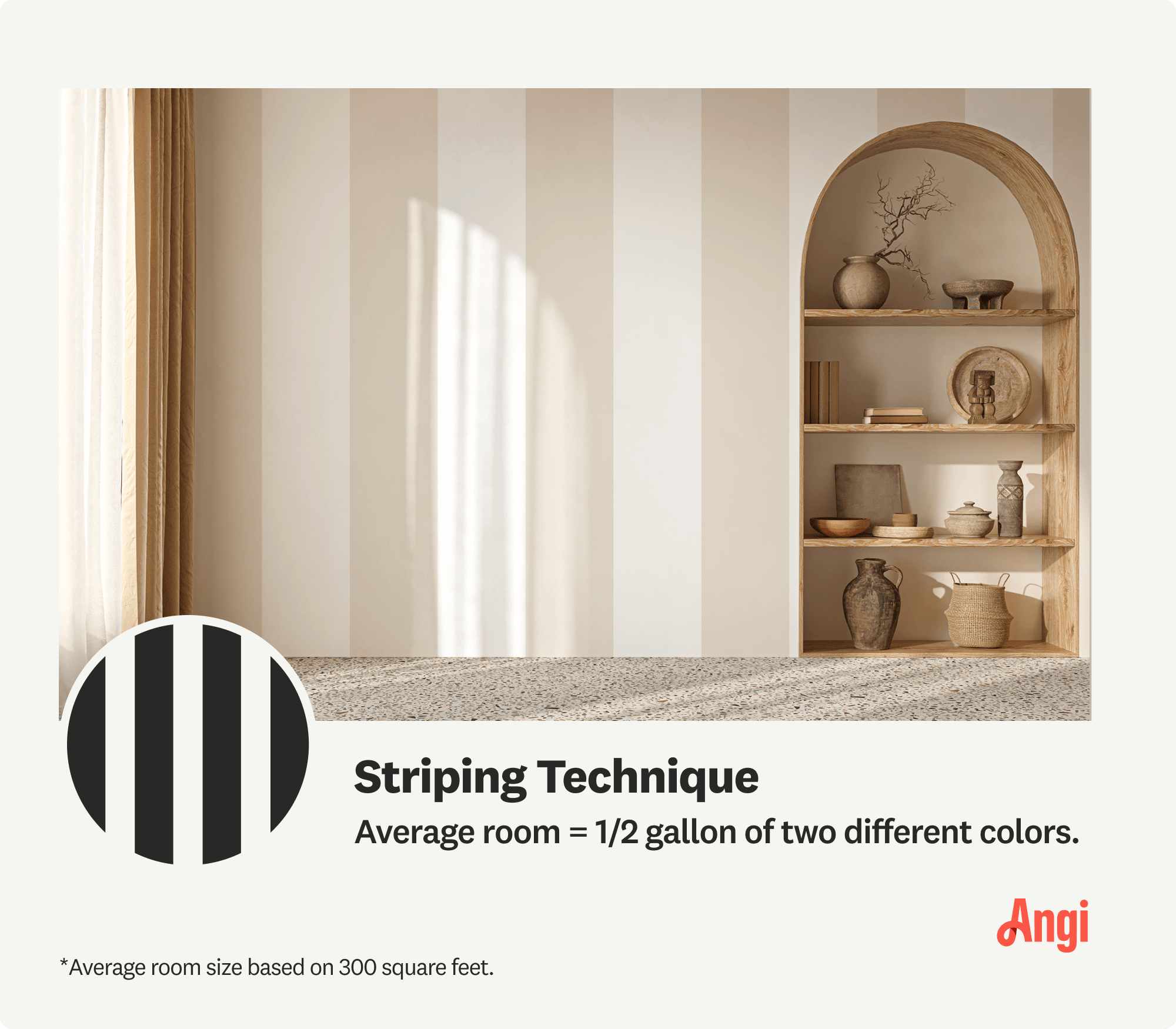
This faux painting technique is self-explanatory: you use painter’s tape to tape off stripes and then paint them in alternating colors. Vertical and diagonal stripes are most common, but horizontal stripes can be good options for making accent walls in smaller areas—like alcoves—feel larger.
Stripes are simple to apply, although time-consuming. You’ll need to wait for at least four coats to dry, as opposed to the two coats you’d use if you went with a solid color. You’ll also need to do a bit of math to make sure the stripes are even widths.
| Pros | Cons |
|---|---|
| Somewhat easy | Time-consuming |
| No special tools | Requires planning |
| Good contrast options | Shrinks the room |
Best for: Accent walls in areas you want to look bigger than they are
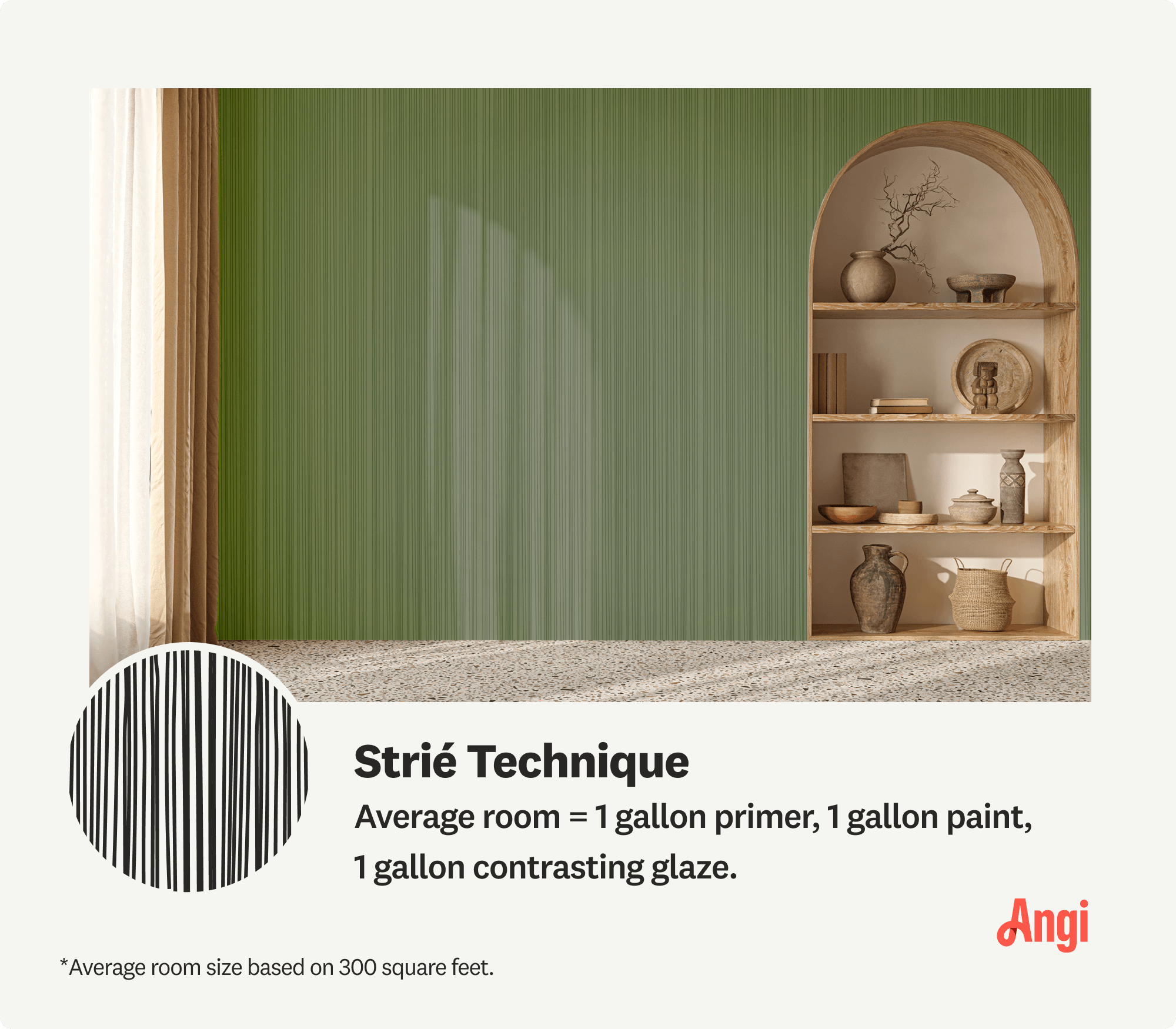
The strié technique is similar to creating stripes, but the final product looks more textured than two-tone. You’ll apply a base coat and then use a stiff, long-bristle brush and a second color to create striations, often in a vertical pattern. This is a bit more subtle than standard striping, but it can still add a lot of character and texture to your home.
You’ll need a steady hand and some patience to create full-length brush strokes across your surface, but overall, this is a relatively simple technique to master.
| Pros | Cons |
|---|---|
| Subtle texture | Time-consuming |
| Somewhat easy | Need a steady hand |
| Luxurious look | Difficult to apply accurately |
Best for: Homeowners who like how striping can expand a room but who want a more subtle texture

As you might guess, the faux denim technique makes your surface look like denim jeans. This adds a ton of texture and character to your space, and it can make it feel luxurious or whimsical, depending on how you decorate around it.
To get this look, paint a white base coat over your wall and then use the same technique you’d use for a strié appearance. Once the vertical lines of the second coat dry, do the same thing but with horizontal lines to create a cross-hatch pattern. To get the look of denim, use dark blue paint.
| Pros | Cons |
|---|---|
| Luxurious appearance | Time-consuming |
| Adds tons of texture | Tough to get right |
| Unique | Can be unattractive if not done well |
Best for: People who love the look of denim and natural cloth as decor
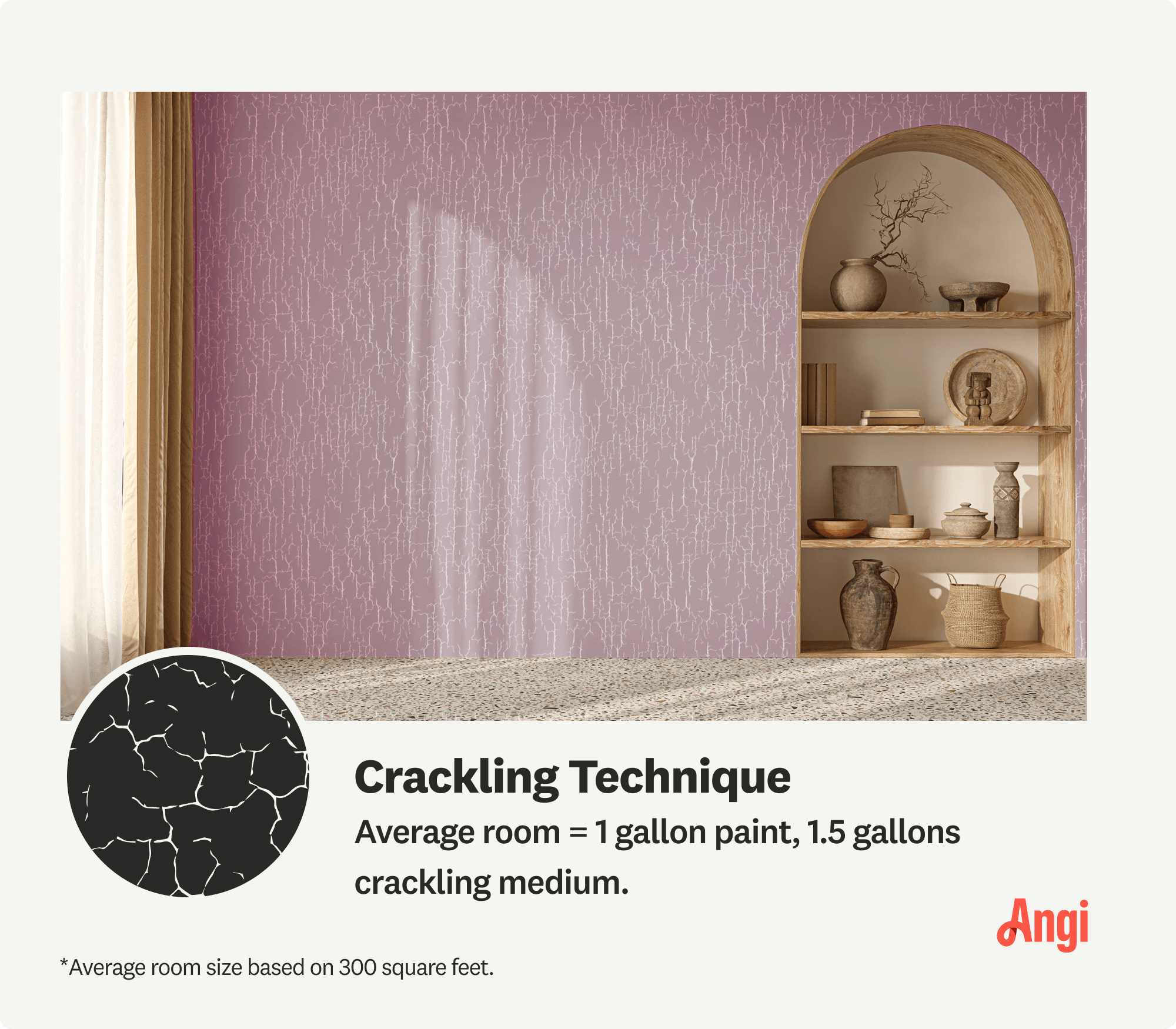
Crackling is a technique that leaves your wall looking cracked but still neat and clean. This demands a special crackle finish that shrinks as it dries, adding a random texture to your surface.
The crackled look is relatively simple to get right, as the special glaze does all of the work for you. However, since you’ll need one to two base coats of paint, the crackle glaze, and a final sealant to finish it off, expect the application to be time-consuming.
| Pros | Cons |
|---|---|
| Simple to apply | Time-consuming |
| Natural appearance | Expensive |
| Excellent for accent walls | Difficult to fix |
Best for: Adding unique and random textures to your surface
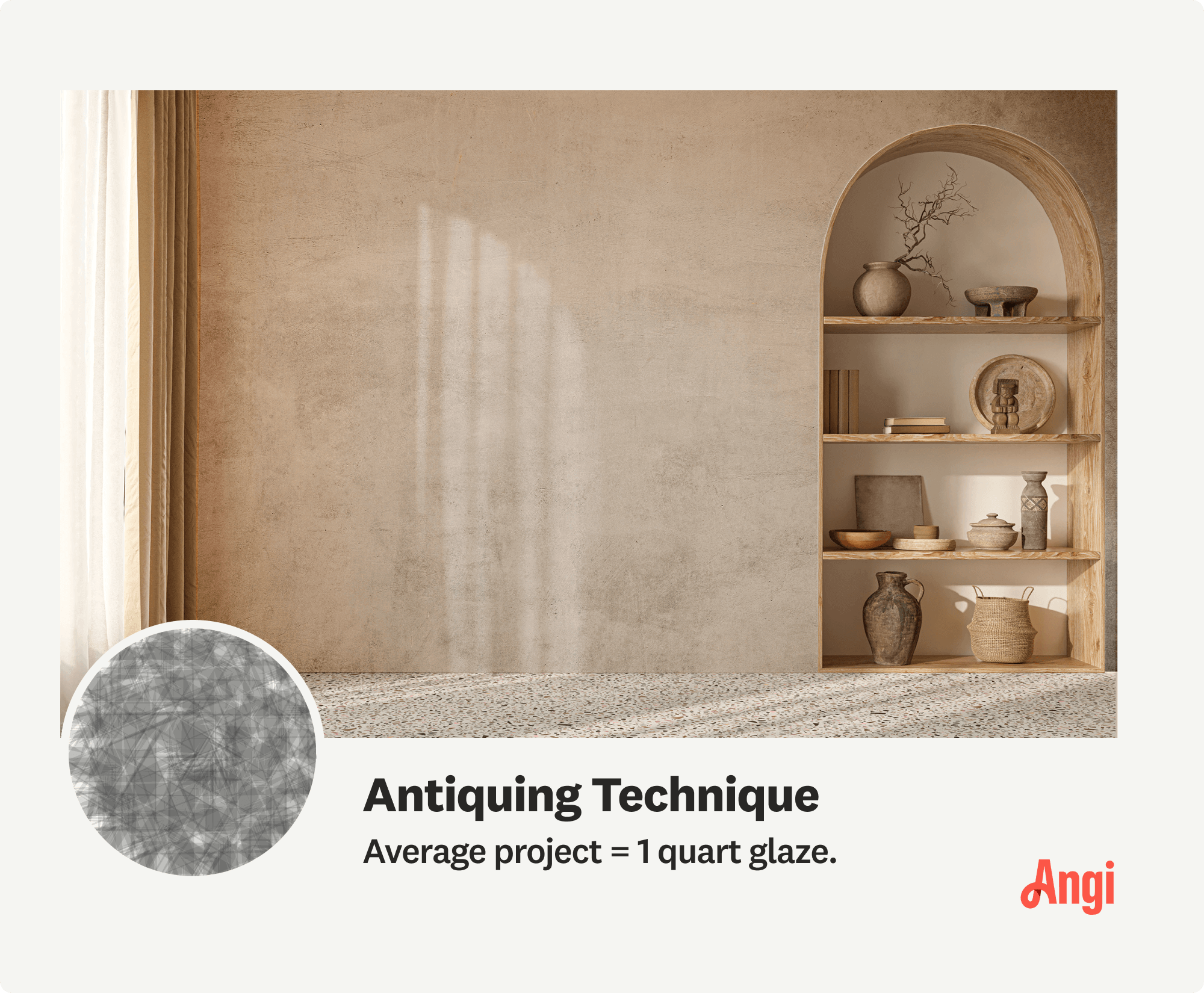
Antiquing is similar to color washing and rag rolling, but it creates an even more drastic aged appearance than either of those two methods. It can instantly make a wall or piece of furniture look right at home among true antiques or a vintage aesthetic.
To get this appearance, apply a base coat of paint and let it dry. Then, use the same technique you would for color washing: apply half-paint and half-glaze over your wall using a brush. Before the top coat dries, wipe it down with a rag to get a more weathered appearance. You’ll want a protective top coat, too, so this is a time-consuming process.
| Pros | Cons |
|---|---|
| Weathered look | Time-consuming |
| Ideal for furniture | Tough to get right |
| Adds vibe to older spaces | Can easily age the room |
Best for: Instantly aging furniture

Leathering will make any surface look like aged, worn-in leather, so it adds lots of character and warmth to your space. You can use this to bring character to an accent wall without the cost of leather, but it also works well on furniture.
Getting this look is tricky and time-consuming. You’ll start with a base coat and then apply a second coat made from one part paint and four parts glaze. Crumple up a piece of painter’s plastic and apply it to the wet paint using a clean brush. Once the paint dries, peel off the plastic.
| Pros | Cons |
|---|---|
| Adds warmth | Very challenging |
| Great for furniture | Time-consuming |
| Inexpensive way to add natural texture | Darkens the room |
Best for: Homeowners who adore the look of leather but don’t love the price tag or the ethical implications
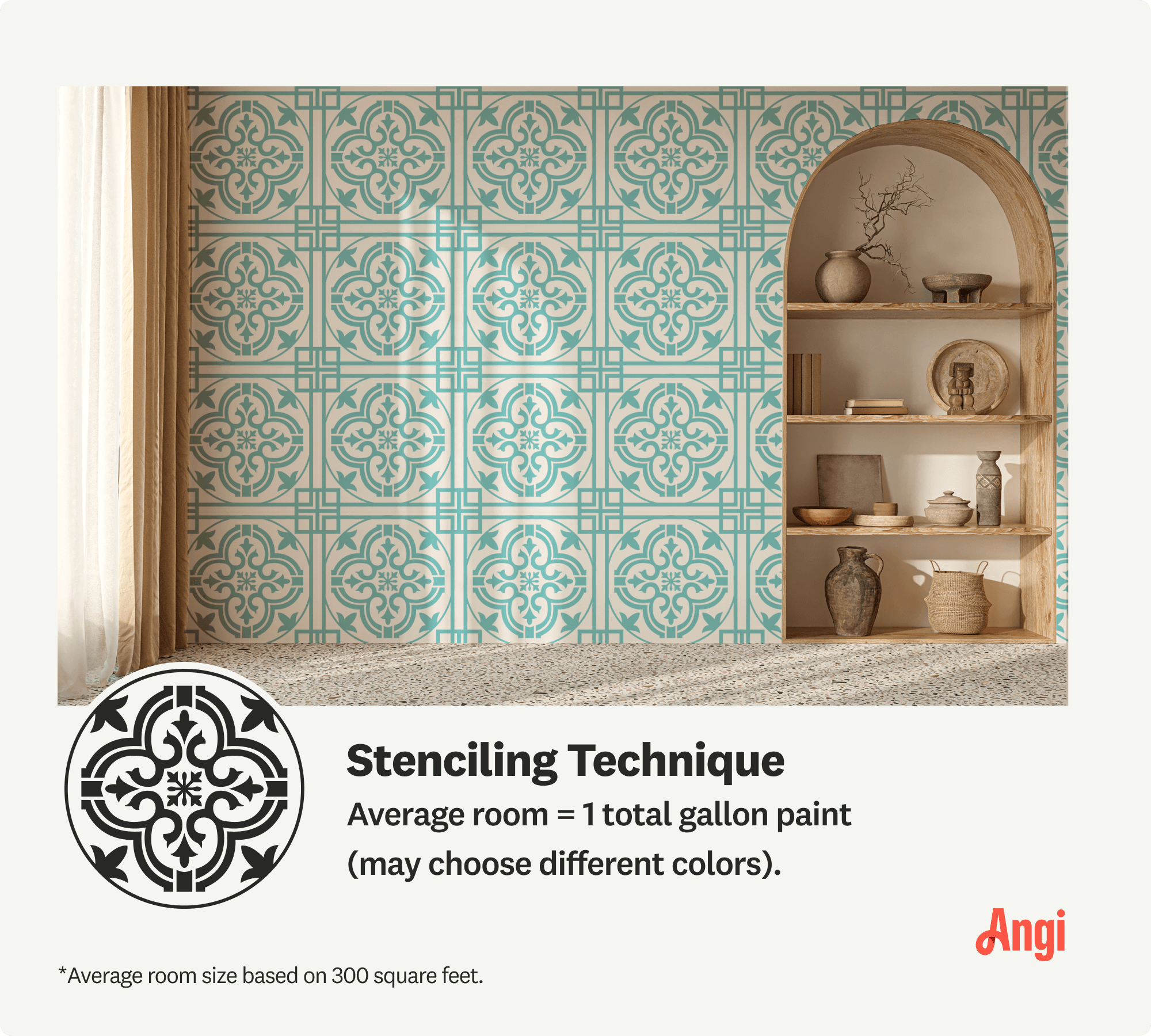
Stenciling is one of the most versatile faux painting techniques you can use, as the only limit to the texture and look you create is your imagination and ability to get the stencils you want. You can choose everything from a floral stencil for an antique look to geometric shapes for a more modern appearance.
To stencil a surface, you’ll apply a base coat, tape on your stencil, and then paint over the stencil. Once the paint dries, carefully remove the stencil and repeat the process across the surface.
| Pros | Cons |
|---|---|
| Highly customizable | Tough to get right |
| Affordable | Very time-consuming |
| Can design yourself | Hard to paint over |
Best for: Homeowners who want a truly custom and unique look on accent walls
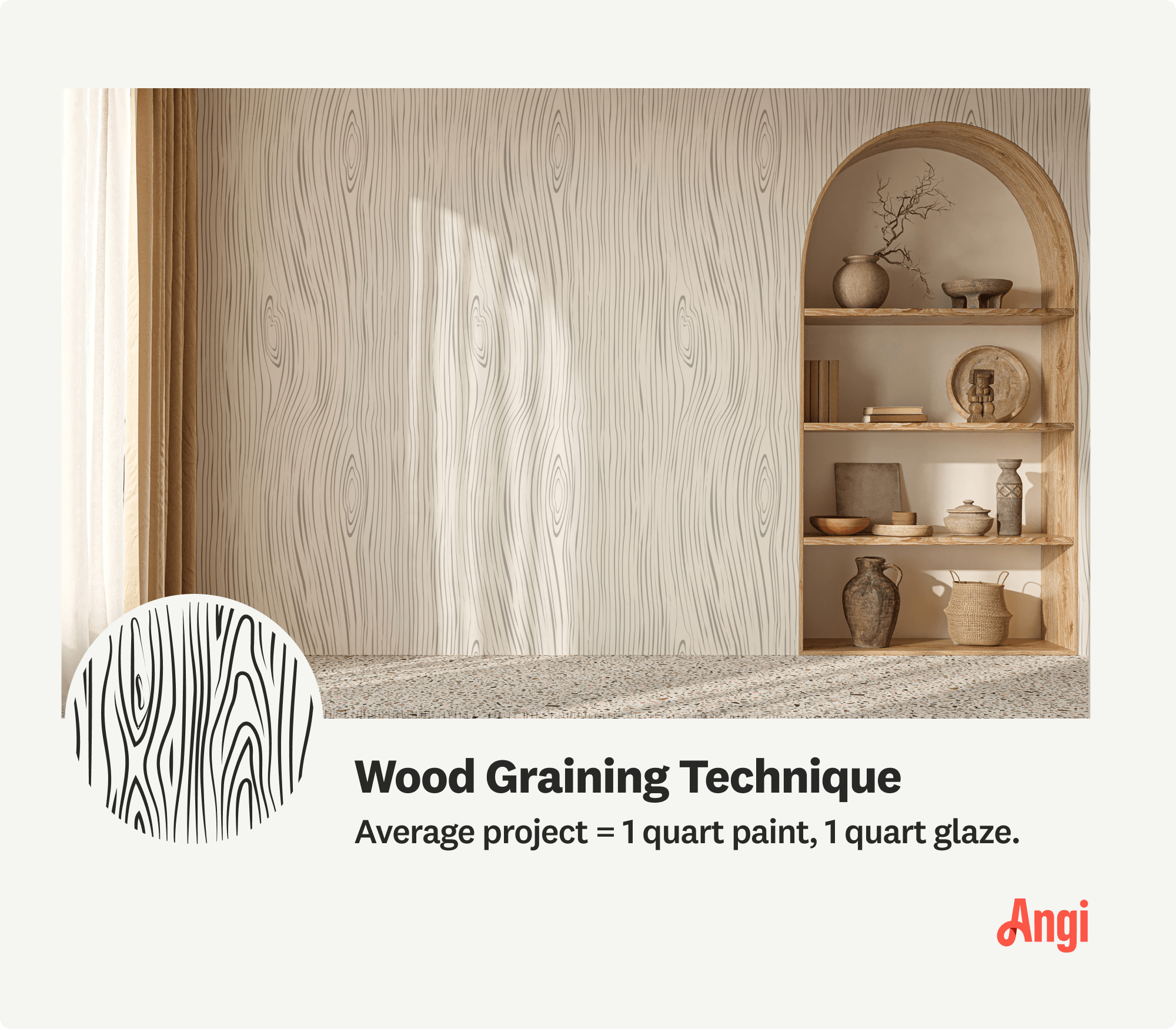
Wood graining is a faux painting technique that uses special tools to make any surface look like natural wood. You apply a base coat, wait for it to dry, then apply a second coat and drag a wood grain rocker or comb while it’s still wet to mimic the natural texture of wood grain.
Wood graining can be tough to get right, and it requires some special tools. However, with the right paint colors and application technique, you can bring the warmth and natural feel of wood to any surface at an affordable price.
| Pros | Cons |
|---|---|
| Adds warmth | Need special tools |
| Mimics real wood | Hard to get right |
| Warms a space | Requires a lot of practice |
Best for: Adding the warmth and natural feel of wood to a surface

If you love the cool texture and look of concrete countertops or tabletops, a faux concrete painting finish might be right up your alley. This can add some modern flare or an industrial appearance to any decor.
To get this look, you can mix plaster with grays and a touch of black paint before applying it to your surface. Alternatively, you can hire a professional painter to apply the look to a surface that you’ve already finished.
| Pros | Cons |
|---|---|
| Cool texture | May require a pro |
| Modern appearance | Time-consuming |
| Accents plants well | Can look cold |
Best for: Homeowners looking to add a touch of modernity or an industrial feel to their space
Venetian plaster is one of the most expensive yet beautifully dramatic painting styles. The finished work evokes old-world charm, but it can be extremely difficult to get right. There is a reason pros charge hefty amounts for this style of painting. For a simpler application with similar results, consider using limewash paint.
Venetian plaster involves multiple applications to achieve the weathered, high-depth look. It isn’t very DIY-friendly, so we recommend hiring a seasoned pro. Most Venetian plaster walls are shades of creams and grays.
| Pros | Cons |
|---|---|
| Every wall unique | Expensive |
| Incredible texture | Extremely difficult to get correct |
| Elegant | Very difficult to fix |
Best for: Homeowners with spare cash looking for a truly elegant accent wall that almost acts as artwork in itself
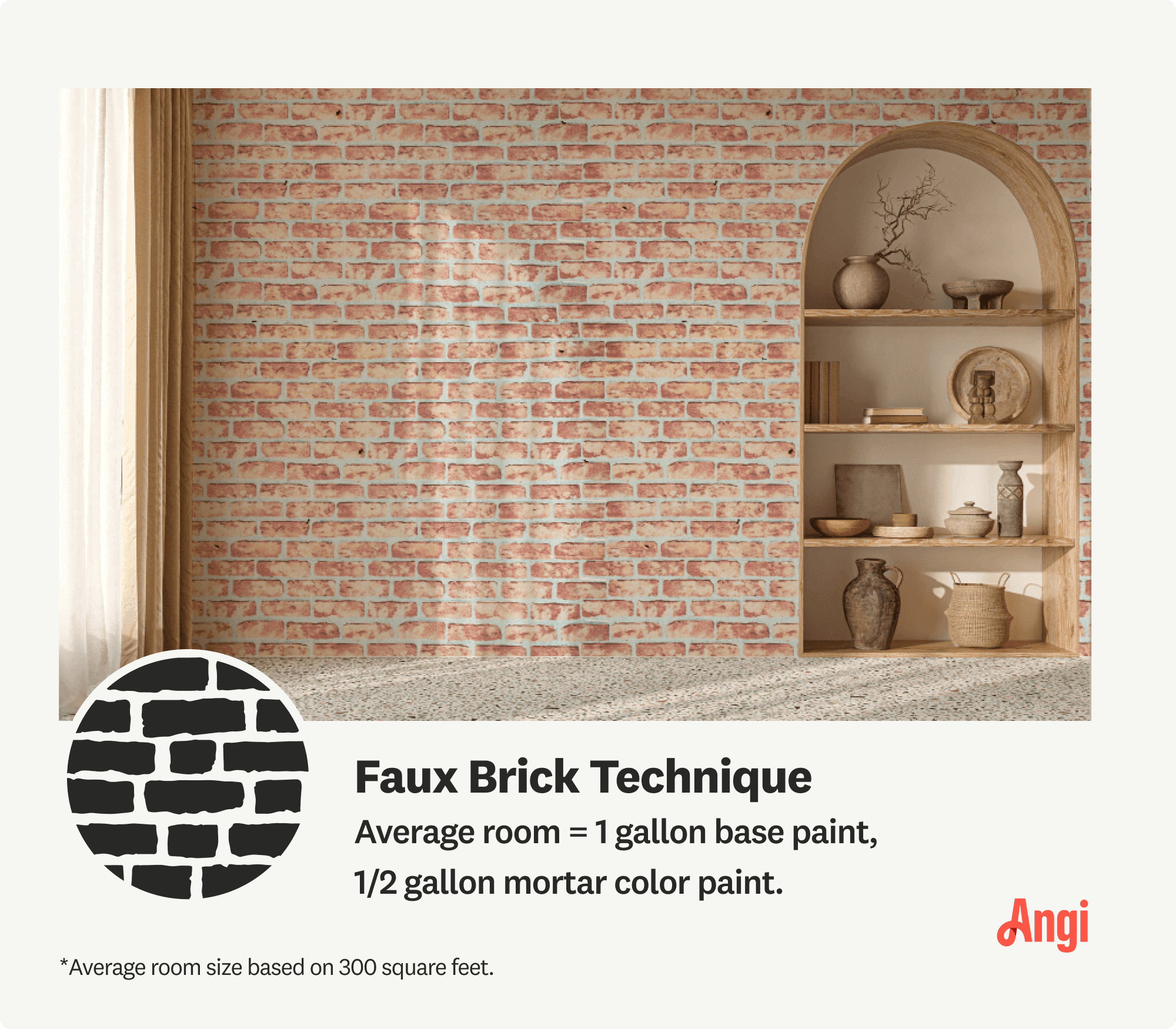
Faux brick, as the name implies, adds the look and feel of a brick wall to your space without the heavy and expensive materials you’d otherwise need. This creates lots of deep texture and adds some modern-yet-natural flair.
This is another time-consuming technique that can be tough to get right. You’ll apply a base coat that will act as the “mortar” and then tape off and paint the bricks across the surface. You can use a sea sponge or the ends of a stiff paintbrush to get that natural brick look.
| Pros | Cons |
|---|---|
| Stunning appearance | Tough to get right |
| Natural texture | Time-consuming |
| Adds an industrial look | Can be replaced with faux brick wrap |
Best for: Homeowners who long for a natural brick wall but aren’t experienced with masonry work
To decide on the right option, you’ll want to consider a few contextual details about your project.
How much natural light does the room receive? This will help determine how heavy-handed your technique should be.
What do you use the room for? This will tell you what kind of paint you should use. For example, a kitchen will need high-gloss paint for easy cleanup, whereas semi-gloss works well for bathrooms in terms of moisture resistance.
How big is the project, and how much time will it take? If you have the time and energy to invest in the project—great. If not, it may be time to call in the pros.
Depending on the finish you choose, you’ll paint with two, three, and sometimes four or more colors, layering as you go. Some techniques, like sponging, are simple and DIY-friendly. Others, like marbleizing, need the expertise of a local painter.
You would save money by doing any painting work yourself, as interior painters charge between $20 and $100 per hour. Pros also charge on the higher end of that range for specialty painting such as this.
Some of these painting techniques you can tackle yourself, such as sponging or rag rolling, while others, such as Venetian plaster or faux denim, are best left to the pros. Many homeowners underestimate the time and experience required to apply faux painting techniques in ways that don’t appear clumsy. Unless you have experience or don’t mind some personal character in the final product, we recommend hiring an interior painter near you.
Precision and professionalism define Custom Paint Jobs LLC. We couldnt be happier.
Window Depot did an amazing job on my deck. I wasnt sure what I wanted to do, but their composite decking was affordable and will last a long time. I am excited to have family over, and I am no longer embarrassed by my backyard. Jeff and the ground crew were polite, respectful, and caring for...
AFS was excellent from start to finish. Jess, the sales associate, was fantastic...very knowledgeable and very professional. The installation crew was excellent. I couldn't be more pleased with the process. Best of all, my new floor looks fantastic!
We used Unique Hardwood Floor LLC three years ago to work on the floors of a 70 year old home that needed a great deal of work. Some floors needed repairs, some were replaced and others just needed to be refinished. It was a complicated job as they needed to blend the old and the new to...
From average costs to expert advice, get all the answers you need to get your job done.

The cost to paint the interior of a house in Dallas, TX depends on size, layout, type of surface, and more. Learn what factors can influence your total in this guide.

The cost to paint the interior of a house in Minneapolis, MN depends on size, layout, type of surface, and more. Learn what factors can influence your total in this guide.

The cost to paint the interior of a house in Seattle, WA depends on size, layout, type of surface, and more. Learn what factors can influence your total in this guide.

What are the best paint colors that complement red brick? Check out our guide to discover the right shade of paint for your red brick home.

Wondering how much you should pay a painter upfront? Check out this guide to learn when and how much you can expect to pay house painters for services.

Knowing how to paint stair railings is a useful trick in your DIY bag. Here are the simple steps necessary to achieve a professional-looking job.